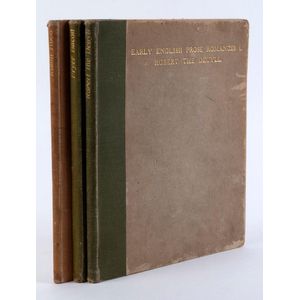Early English Prose Romances
This site contains only a limited number of works of art sold in Australia and New Zealand, and is not representative of the art market for any artist. For a comprehensive art database visit our specialist site, Australian Art Sales Digest which includes over 400,000 works auctioned in Australia and New Zealand by over 30,000 artists, covering the period from the early 1970s to the present day.
William Thomas & Harold Nelson: Early English Prose Romances: Robert the Deuyll, Robin Hood and Fryer Bacon, [Edinburgh, Otto Schulze, 1904], Three volumes, first edition set. 4to. Buckram spine, lettered in gilt, over paper boards. 1 of 500 copies, unnumbered. Decorative title pages printed in red & black, black & white woodcut plates, decorative borders & line drawings. The style of this set of books owes much to William Morris' Kelmscott Press and the Arts & Crafts movement. The drab boards give way to hand made paper, wood engravings, Art Nouveau swirls and gothic fonts.
You must be a subscriber, and be logged in to view price and dealer details.
Subscribe Now to view actual auction price for this item
When you subscribe, you have the option of setting the currency in which to display prices to $Au, $US, $NZ or Stg.
This item has been sold, and the description, image and price are for reference purposes only.
- Manner of .... / Style of ..... - A cataloguing term where the item, in the opinion of the cataloguer is a work in the style of the artist, craftsman or designer, possibly of a later period.
- Morris, William - William Morris (1834 - 1896) an architect designer, artist, writer, poet and social activist is regarded as a leader of the Arts & Crafts movement in England.
After studying theology, ecclesiastical history, medieval poetry and art at Oxford University, Morris began work with a firm of architects for a short period.
In 1861 he formed a company Morris Marshall, Faulkner & Co. was formed to design and produce wallpaper, carpets, tapestries and stained glass, and they initially secured ecclesiastical works, later extending to domestic assignments.
In 1874 he took sole control of the company, buying out the other partners, and renaming it Morris & Co.
The origins of his designs can be traced to medieval Gothic styles but his organic flower and bird motifs encouraged later artists to seek inspiration for their designs in nature. - Art Nouveau Period - The Art Nouveau period was a cultural movement that emerged in the late 19th century, and was characterized by its emphasis on natural forms, flowing lines, and a decorative, ornamental style. Art Nouveau was a reaction against the ornate and heavily stylized designs of the previous era, and sought to create a new, more organic aesthetic.
Art Nouveau was characterized by its use of sinuous, curving lines, as well as a focus on natural elements such as flowers, vines, and other organic shapes. Art Nouveau designers sought to create a total work of art, in which every element of a building or object was designed to be harmonious with the overall design.
Some of the most iconic examples of Art Nouveau design include the Paris Metro entrances designed by Hector Guimard, the works of the artist Alphonse Mucha, and the architecture of Victor Horta in Brussels.
The Art Nouveau period was at its peak between 1890 and 1910, but began to decline in popularity by the start of World War I. However, Art Nouveau remains an important influence on design and art to this day, and continues to be celebrated for its emphasis on natural forms and decorative style.
This item has been included into following indexes:
- engravings and lithographs 1,678
- lithographs 1,700
